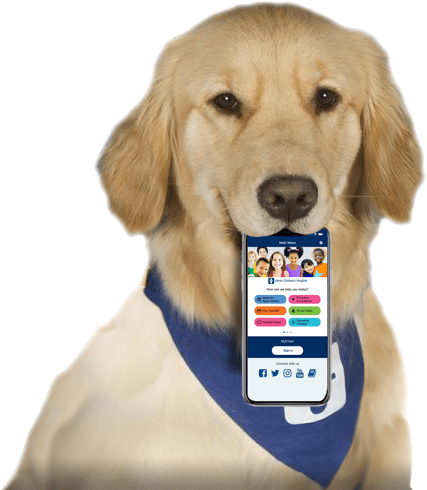Food Allergies
What Are Food Allergies?
A food allergy happens when the body's immune system, which normally fights infections, sees the food as an invader. This leads to an allergic reaction.
Even if previous reactions have been mild, someone with a food allergy is always at risk for the next reaction being life-threatening. So anyone with a food allergy must avoid the problem food(s) entirely and always carry emergency epinephrine.
What Are the Most Common Food Allergens?
A child could be allergic to any food, but these common allergens cause 90% of all reactions in kids:
What Are the Signs & Symptoms of a Food Allergy?
An allergic reaction is an immune system response in which chemicals like histamine are released in the body. An allergic reaction can be mild or severe. A person can have a severe reaction to a food even if their previous reactions were mild. Symptoms of an allergic reaction can include:
- wheezing
- trouble breathing
- coughing
- hoarseness
- throat tightness
- belly pain
- vomiting
- diarrhea
- itchy, watery, or swollen eyes
- hives
- red spots
- swelling
- a drop in blood pressure, causing lightheadedness or loss of consciousness (passing out)
Sometimes, an allergy can cause a severe reaction called anaphylaxis. Anaphylaxis might start with some of the same symptoms as a less severe reaction, but can quickly get worse. The person may have trouble breathing or pass out. More than one part of the body might be involved. If it isn't treated with injectable epinephrine, anaphylaxis can be life-threatening.
What Is a Food Intolerance?
People often confuse food allergies with food intolerance. The symptoms of food intolerance can include burping, indigestion, gas, loose stools, headaches, nervousness, or a feeling of being "flushed." But food intolerance:
- doesn't involve the immune system
- can happen because a person can't digest a substance, such as lactose
- can be unpleasant but is rarely dangerous
How Is a Food Allergy Diagnosed?
If your child might have a food allergy, the doctor will ask about:
- your child's symptoms
- the time it takes between eating a particular food and the start of symptoms
- whether any family members have allergies or conditions like eczema and asthma
The doctor might refer you to an allergist (allergy specialist doctor), who will ask more questions and do a physical exam. The allergist probably will order tests to help make a diagnosis, such as:
- a skin test. This test involves placing liquid extracts of food allergens on your child's forearm or back, pricking the skin, and waiting to see if reddish raised spots (called wheals) form. A positive test to a food shows that your child might be sensitive to that food.
- blood tests to check the blood for IgE antibodies to specific foods
Your child may need to stop taking some medicines (such as over-the-counter antihistamines) 5 to 7 days before the skin test because they can affect the results. Check with the allergist's office if you are unsure about what medicines need to be stopped and for how long.
If the test results are unclear, the allergist may do a food challenge:
- During this test, a person slowly gets increasing amounts of the potential food allergen to eat while being watched for symptoms by the doctor. The test must be done in an allergist's office or hospital with access to immediate medical care and medicines because a life-threatening reaction could happen.
Food challenge tests are also done to see if people have outgrown an allergy.
How Are Food Allergies Treated?
A child who has a food allergy should always have two doses of epinephrine nearby in case of a severe reaction. Epinephrine is a prescription medicine that comes in a small, easy-to-carry container. It's easy to use. Your doctor will show you how. Always have two doses nearby in case one doesn't work or your child needs a second dose.
The doctor can also give you an allergy action plan, which helps you prepare for, recognize, and treat an allergic reaction. Share the plan with anyone else who needs to know, such as relatives, school officials, and coaches. Wherever your child is, caregivers should always know where the epinephrine is, have easy access to it, and know how to give the medicine. Also consider having your child wearing a medical alert bracelet.
Time matters in an allergic reaction. If your child starts having serious allergic symptoms, like trouble breathing or throat tightness, use the epinephrine right away. Also use it right away if symptoms involve two different parts of the body, like hives with vomiting. Then call 911 and have them take your child to the emergency room. Medical supervision is important because even if the worst seems to have passed, a second wave of serious symptoms can happen.
How Can Parents Keep Kids Safe?
If your child has a food allergy, carefully read food labels so you can avoid the allergen. Ingredients and manufacturing processes can change, so it's important to read labels every time, even for foods your child has had safely in the past. The most common allergens should be clearly labeled. But less common allergens can be hidden in ingredients like natural flavors or spices.
One thing that might not show up on a label is cross-contamination risk. Cross-contamination happens when a food you are not allergic to comes in contact with a food you are allergic to. This can happen if a manufacturer uses the same equipment to grind lots of different foods, for example. Some companies state this on their labels to alert customers to the risk of cross-contamination with messages like: "May contain peanuts," "Processed in a facility that also processes milk," or "Manufactured on equipment also used for eggs." You'll want to avoid products that have these kinds of alerts.
But companies are not required to put cross-contamination alerts on a food label. So it's best to contact them to see if a product might been in contact with your child’s allergens. You may be able to get this information from a company website. If not, contact the company and ask.
When your child eats away from home, make sure anyone preparing food knows about the allergy and which foods to avoid. You may want to provide food that you know is safe for your child.
You can learn more about managing food allergies online at:
Reviewed by: Larissa Hirsch, MD
Date Reviewed: Oct 10, 2024

















